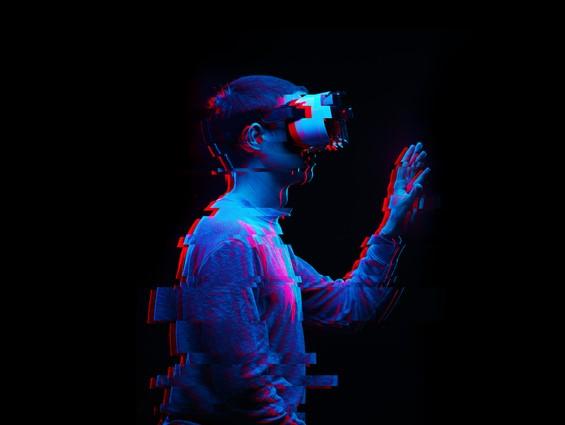Let’s be clear: the metaverse (however you define it) is decades away.
Which is not to say that it can be ignored in the meantime. Because while it may seem like science fiction or over-inflated hype at the moment, the fact remains that huge amounts of money and effort are being poured into making it happen – and educators need to at least be aware of its possible implications.
What is the metaverse?
There is no single definition.
It’s often described as the internet but in 3D: an immersive virtual world where users can socialise, play and work. Using our mobile devices, PCs and game consoles, we will all share collective virtual spaces, participate in new digital experiences and have the opportunity to be part of an online economy where we can create, own and sell digital assets.
The metaverse will run 24/7: it will never stop. Our digital avatars will be able to flit seamlessly from one virtual world to another, wearing clothes bought in the metaverse and interacting with other avatars.
That’s the vision, anyway.
- The metaverse is much more than a virtual copy of your campus
- Immersive tech in teaching and learning: first steps into the metaverse
- The metaverse will change everything – including academic research
What the metaverse is not
The metaverse is not virtual reality.
Virtual and augmented reality (VR/AR) are already well-defined technologies that are being used now to benefit education. While the metaverse will be accessible through VR headsets or AR glasses, VR/AR technology will only be one of the components for interacting with the metaverse.
It’s not a single entity.
The metaverse will not be owned by one company; rather, it will be a vast, decentralised network of connected virtual spaces that includes the sum of all virtual worlds, augmented reality and the internet.
It’s not a step change.
The metaverse will evolve from the convergence of a range of existing technologies: not just VR/AR but artificial intelligence (AI), blockchain, cybersecurity and connectivity.
And it’s not here yet.
It’s important to bear in mind that the metaverse is still very much a hypothetical concept that requires extraordinary technical advancements before it can be made to function as intended. For example, there is no protocol yet that would allow avatars to move from one virtual world to another – which is one of the metaverse’s fundamental tenets.
What might the metaverse mean for education?
The education metaverse is being touted as a virtual reality teaching environment that will enable a more immersive style of teaching and learning: an “embodied” internet where, instead of just viewing content, we will be in it.
But educators really need to ask: “So what? What is it about immersion that leads to a better, more engaging learning experience? And what does ‘engaging’ really mean?”
And how will this be different from our current use of VR?
As we know, VR headsets, simulators and full-body immersion suits are already adding value to education by providing a virtual alternative to real-world experience. By simulating complex environments they can give learners extra practice in otherwise dangerous, tricky or expensive physical tasks such as repairing offshore wind farms, for example.
However, one big difference to note between VR and the metaverse is that, while the experiences in VR systems cease the moment you switch them off, the metaverse – being a shared and persistent world – will continue to run. So, even when you remove your headset and exit the metaverse, your avatar could still be present in the digital world. Acting as a digital twin and using AI, it would continue to undertake tasks such as gathering resources for your next assignment.
The technology still has a long way to go
Plenty of hurdles need to be overcome before the metaverse has any impact on education.
For a start, the next level of immersive reality will require much more complex technology.
We are far from being able to produce shared, persistent simulations synchronised in real time for millions of users. The world just doesn’t have enough online infrastructure to sustain that number of people accessing the metaverse at the same time. It has been suggested that current state-of-the-art computational efficiency would need to increase by 1,000 times to power truly persistent and immersive computing at scale.
And that amount of computing power will obviously go hand in hand with a major increase in carbon emissions. While the metaverse might limit the need for physical travel, this has to be weighed against its reliance on technologies such as blockchain, which is extremely energy hungry.
Then there are the legal, regulatory and ethical issues...
As the next iteration of the digital economy, the metaverse will empower users to develop their own virtual spaces and solutions. This would establish a creator economy that allows users to own virtual assets and experiences that have a “monetary” value. Whether that value will be transferable between different virtual worlds (or into the real world) remains unclear – but the fact that parts of the metaverse will be profit-driven could make it incompatible with the mission and values of education.
To access the metaverse will also require more – and more expensive – kit. That’s always a barrier to mass adoption and could widen the existing digital poverty gap.
And last, but by no means least, is the issue of data privacy.
The metaverse will enable – or even require – the collection, analysis and use of personal data from every user, including the tracking of eye and finger movements, or facial reactions. Monetising these data and sharing them with other parties constitutes the risk with the widest implications when it comes to privacy in the metaverse.
Making it a safe place for learners will require an overhaul of current legal and regulatory procedures, a reimagining of the security landscape and significant changes in user behaviour.
So, how should educators start preparing for the metaverse?
It’s important to be critical about what are being presented as the benefits of any new technology, and the metaverse is no exception.
While there may well be some exciting, transformational applications in the educational field, these are early days, and it will be difficult to determine appropriate strategies for use until the infrastructure matures.
The metaverse will most likely emerge in business and entertainment first – and by then it may be too late to influence how it develops and how to address the evolving technological, legal and ethical challenges around its use.
For now, educators should focus on proven technologies and look at using AI and VR to lay the groundwork for future advances.
Paul Bailey is head of co-design at Jisc.
If you found this interesting and want advice and insight from academics and university staff delivered direct to your inbox each week, sign up for the THE Campus newsletter.



comment